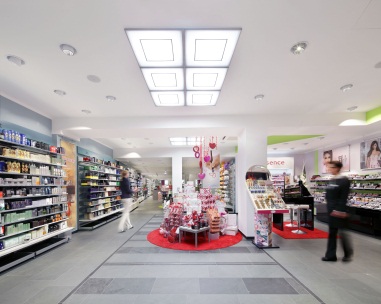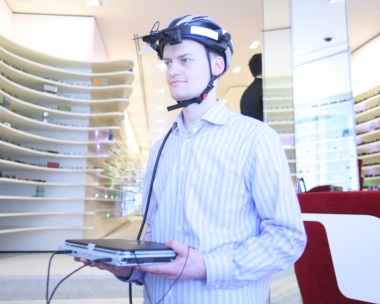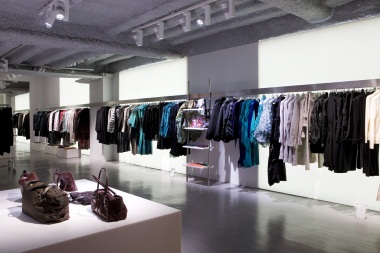In the competitive high-street environment, the temptation is for retailers to illuminate their stores, shelves and shop windows with a dazzling array of light and colours, resulting not only in a bewildering shopping experience for customers but also in costly energy bills and accusations of failing to act in an environmentally responsible manner for retailers.
It was this background that gave rise to two separate studies supported, and joined together, by lighting manufacturer Zumtobel. “When one shop in a mall is bright, the neighbour makes theirs even brighter,” says Professor Jan Ejhed, head of the Lighting Laboratory at the Royal Institute of Technology in Sweden. “So the tendency is very negative; we have shops with 700W/m2 installed and it creates heating that you must ventilate. We can’t go on like this.”

Shoppers’ paradise Different colour temperatures and brightness levels can attract consumers to certain products or direct them to particular parts of a store
Ejhed oversaw the first study, which sought to examine to what extent lighting influences consumers’ subjective preferences. A total of 97 people - 59 professionals and 38 non-professionals - were asked to compare and assess three virtual reality lighting situations in shops and retail spaces. The research looked at three areas in particular: the shop window, the store and the shelving displays.
With the window, people preferred brighter light, says Ejhed, and vertical rather than horizontal lighting to help products, such as clothes, stand out from the background. “The important factor here is that they were not so sensitive to the colour rendering; they are more sensitive to that when they come into the shop,” he says.
In the store itself, the research found that, although brightness was important to customers, this was only the case up to a certain point and other factors - such as colour temperature and rendering - were just as significant. “People prefer warm lighting and moderate brightness, and they are connected, to a certain extent,” says Ejhed. “It’s somewhere around 3,000K or 4,000K but when you get to 5,000K or 6,000K, they don’t find it comfortable any longer.”

The headset used in the second study tracked the wearer’s eye movements as they looked at the shelves in a store Buying power Control systems will allow retailers to focus their customers’ attention on different areas of the store through the use of a variety of colours and light levels
Compare and contrast
Significantly, too, the study found varying the lighting - such as changing the colour according to the time of day or when a specific promotion was on - also appealed. “If you design the installation in a smart way, people will follow tracks around a store and you can get them into the deep part of the shop by changing the brightness or the colour temperature,” he says. “We’re reacting to the differences all the time.” When it came to the shelf displays, however, more light was preferred, as customers wanted to be able to examine items ahead of making a purchase.
This study was complemented by a second, designed by Markus Felsch, managing director of Felsch Lighting Design, and developed by Dr Roland Greule of Hamburg University of Applied Sciences. This sought to monitor people’s instinctive reactions when presented with different lighting schemes by using eye-tracking technology to monitor where they looked when presented with a series of slides and real-life lighting schemes in two retail stores.
This research revealed a number of things, the most significant of which was that people’s eyes were naturally drawn to areas of contrast, where dark and light areas overlapped, rather than to the most brightly lit areas. “This is really interesting to note,” says Felsch, “because most of us have forced people to look to the bright places.”
Another less-surprising conclusion was that people tend to look at products that are located at head height, meaning that those placed on shelves that are higher or lower than this are often overlooked. “If you want to force attention on these areas you have to lift them up to the height of people’s faces, or you can put in dynamic lighting, which means changing the brightness,” he says.
These two findings were tested out at a concept store in Hamburg, using 14 different lighting scenarios, including changing colour and deploying different arrangements at different times of day. The overall conclusion was that people’s eyes were instinctively drawn to the areas where the lights were active, says Felsch, including shelves that were lower down, and were attracted to blue lights more than any other colour. This logic can also be extended to stores as a whole. “If you make the unloved areas in your shops attractive, people see more areas of the shelves and more products, and the time they stay in the shop increases,” he adds.

Buying power Control systems will allow retailers to focus their customers’ attention on different areas of the store through the use of a variety of colours and light levels
Pick’n’mix
The need to adapt both lighting levels and colours in shop windows, stores and shelving displays could see a greater demand for the use of LEDs and control systems in such areas, suggests Birthe Tralau, lighting application manager at Zumtobel, who helped to oversee the project.
“Up to now there hasn’t really been a desire from customers for controls when designing shop layouts but this study has shown - especially with dynamic light or when you can adjust the colour temperature - that it can be very beneficial,” she says. “It’s only possible with LEDs, because to have two different spotlights and two different colour temperatures is just not practical.”




